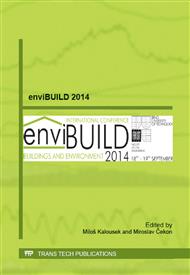p.371
p.377
p.381
p.386
p.390
p.395
p.399
p.403
p.408
Evaluation of Illuminance of Rooms Oriented to Different Cardinal Points
Abstract:
Daylighting levels in interiors are changed every day since sunrise to sunset in dependence on luminous exterior conditions. Indoors are illuminated by diffuse skylight prevailing time of the year in Central European counties while a lot of sunny situations occur mainly during transitional and summer periods. The later can produce overheating as well as glare or disturbing luminance due to excessive sunlight in the space close to windows. If interiors are designed with screened work places the influence of direct sunlight during working time has to be evaluated.The article will present results of computer daylight simulations in a side-lit office room oriented to cardinal points. The study is focused on daylighting evaluation of the room orientation influence on levels under clear sky conditions and compared with results achieved for the CIE overcast sky model. The calculations were run in software Daylight Visualizer 2.6.7. The daylight simulation show that applying the clear sky model for illumination of oriented rooms, the substantial different illuminances can be resulted compared to outputs from the common overcast sky daylight metrics.
Info:
Periodical:
Pages:
390-394
Citation:
Online since:
October 2014
Authors:
Keywords:
Price:
Сopyright:
© 2014 Trans Tech Publications Ltd. All Rights Reserved
Share:
Citation:


